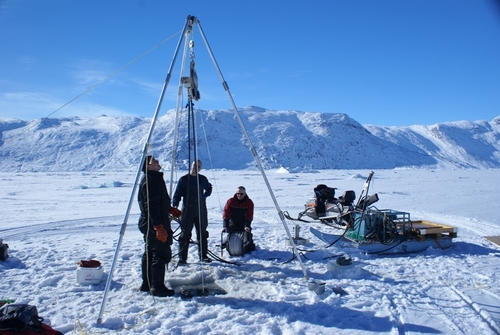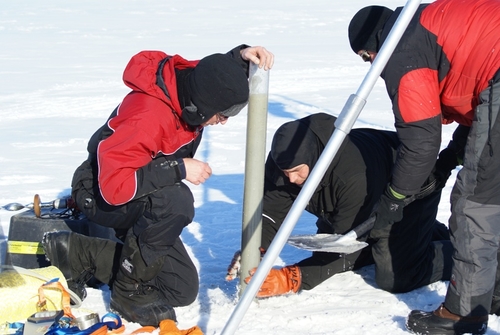Looking back in time – a sediment core project in Godthåbsfjord Published 29.03.2011

At the end of March 2011, geological and oceanographic fieldwork was carried out from the fjord ice in the inner Godthåbsfjord as an essential part of the climate research project “Sedimentation history of Kangersuneq Fiord”.
Because of the very warm start of this winter, there was some uncertainty at the beginning of the year as to whether the planned research program could be completed. However, as a result of more stable and cold weather from mid-January, fjord ice with a thickness of about 30-40 cm formed some 40 km from the Kangiata Nunata Sermia (KNS) glacier, allowing the program to go ahead.
The fieldwork was carried out by a team of 4 people in collaboration between the Greenland Climate Research Center (GCRC) and the Geological Survey of Denmark and Greenland (GEUS). The logistics were based on snowmobile transport starting from Kapisillit located in a fiord in linear approx. 6 km from the Kangersuneq fjord. However, heavier hydraulic core sampling equipment was transported from Nuuk to the ice fjord by helicopter sling. As a first and important part of the expedition, an ADCP current measurement device suspended below the ice earlier this winter was recovered. This was followed by systematic CTD profiling (salinity, temperature, depth), water sampling and core sampling of fjord sediment (upper 2 m) at a total of 6 stations at a distance of approx. 30 km to 15 km from the brink of the KNS Glacier at the base of the Godthåbsfjord.
Furthermore, depth measurements were made using sonar to complement knowledge of the bathymetry of inner Kangersuneq. In all, the team brought home 11 sediment cores, which are all fine-grained and clearly layered. It is expected that the grains represent a period of around 200-500 years before present, and that they may thus be able to shed light on the so-called Little Ice Age period, when KNS is presumed to have been about 20 km further advanced than it is today. The oceanographic and geological data must now be analyzed, and the research material is expected to contribute to a better understanding of the linked oceanographic, glaciological, and geological processes in the Arctic fjord systems.

Making a sediment core ready for transport back to the laboratory in Denmark. Photo: Thomas Juul-Pedersen.

